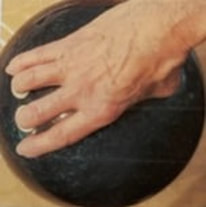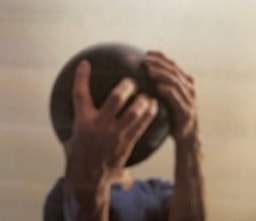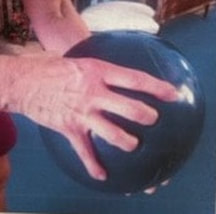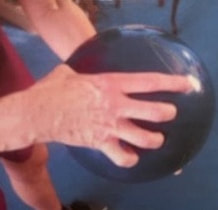|
In my Blog Post from 5/23/22 I spoke about different Hand Position that can be used in Bowling. Here I'd like to mention a few different finger positions I've used over the years and that you may want to try. Fingers aren't used for just holding the ball, they can do more to help improver your pin count and increase your scores! Let me also mention what Axis Rotation and Axis Tilt are: * Axis Rotation--Is the left to right or Horizontal movement of the hand with the ball for the ball release. * Axis Tilt--Is the Up and down or Vertical alignment of the hand with the ball and is a type of spin that is put on the bowling ball by the way a player throws the ball. A Zero Axis Tilt- means that one rotation of the ball goes over the entire surface (usually when a straight ball is thrown), and when the Axis Rotation and Axis Tilt are the same, the ball will go straight. A small or low axis tilt creates a smaller more gradual hook that is easier to control, which gives the bowler a high percentage of good pocket hits and spare conversions. A higher tilt makes the ball turn or hook farther down the lane. The photo below shows some angles of axis tilt. I found it online and if you want to know more, you can go online to get a bit deeper into it. 1. STRAIGHT (CLOSED) FINGERS POSITION: **Keeping your fingers closed or close together on the ball release helps you to stay behind the ball more which produces a Low *Axis Tilt and is great to use on lanes that have little oil (dry lanes). ** Doing this helps with keeping the ball going longer down the lane before it starts to hook, and keeps the hook smaller and more moderate. The ball may feel a little unstable in your hand at first, so you can open the index finger if needed but only slightly. 2. SPREADING INDEX FINGER POSITION: ** Good to use when lanes are slick (have a lot of oil). ** Increases Axis Tilt which helps produce more revolutions on the ball and creates a slightly larger hook. ** Increases the angle of entry into the pins on the back end. 3. SPREADING PINKY FINGER POSITION: ** Makes the ball easier to control. ** Gives more end over end roll. ** Produces a slightly smaller hook than the wide index finger position, thereby helping to increase accuracy. ** Can use the pinky to help guide the ball toward the target. ** Helps decrease the hook on the back end so the ball doesn't keep hooking and possibly come up high on the headpin. 4. TUCKED PINKY FINGER POSITION: ** Helps the ball to go longer down the lane before it starts to hook. **Helps with pushing the ball off the palm. ** Puts a little more snap on the hook at the back end as the ball is going into the pocket. ** To do this, bend the pinky at the first joint so the nail is resting on the balls' surface. If you've never tried these different finger positions before, I recommend giving them a try. You can experiment or deviate from what I've mentioned here if you want, for example try spreading the index finger and pinky at the same time to see what that can do for you with the type of ball you throw, or try squeezing the ring or middle finger and leading the ball with one of them instead of the index finger. Just practice, practice, practice, practice to help fine tune your balls' reaction on the lanes. When you understand what these different finger positions can do, make notes to review so you can use them in your league play. Have fun!! Is it time to clean your ball? Have you been doing those bowling exercises I mentioned on 5/17/21? Join me back here next week when I'll be discussing some Common Bowling Injuries and how to deal with them.
1 Comment
Are you a fairly new bowler who uses an alley ball or just has one of those plastic balls? Has your average improved only a little and you want to get your game up to the next level? Have you only been using a ball with a "Conventional Grip", or have you been working out and can now handle a heavier ball, or has the ball you've been using just not working the same as when you first bought it? If your answer is yes to any of these questions, then it is time for you to purchase a new ball!
A new bowlers average will always improve because they usually don't know much about the game. Some of them may not want to spend a lot of money on equipment until they know they like the sport, which is quite understandable. But if you have been in the sport awhile and you are still using a cheap ball, you need to get yourself a better one that has some STUFF on it! Please re-read my blog post from 5/3/21 about bowling balls. When you buy a new ball at the pro shop, the proprietor will customize the ball and drill it to fit your fingers perfectly which is usually free of charge. You can buy a discounted bowling ball online, but then you'll have to pay for the drilling and shipping anyway. I prefer to purchase it in the pro shop because I like to ask him/her questions and he/she may ask you some questions to have an idea on your bowling style and the type of ball you throw, so the ball can be properly drilled to perform the way you want. As I have mentioned in several of my previous blog posts, using the same ball week after week helps with CONSISTENCY which will definitely help improve your average! If you're at the point where you are getting all the basics down pretty well and your average has improved in the last few years, you may notice that the ball isn't performing the way it did when it was new. Buying a new ball will help you get up to that next level and if you really like the ball, buy a second one immediately if you can afford it. I loved a Storm ball I had bought years ago but then they discontinued it and I was disappointed because I couldn't buy another one. So I just wanted to give you a heads up about that not to make the same mistake I did. I think the best bowling balls to buy are the "Reactive Resin" type with a Weight Block inside which helps the ball to hook, giving a lot more action at the pins. The heaviest ball you can buy is 16 lbs. If you feel that your ball is too light, then switching to a heavier one can get through the pins better and also have less pin deflection. You won't leave the king pin (5 pin) as often which will result in more strikes! Also, just having another ball in your bag to assist you on different lane conditions is another good reason to purchase a new ball. When I was a beginner, I only used one ball that hooked for both my strikes and spares. I missed a lot of 10 pins and then decided to get a plastic ball that just went straight. My average went up about 20-30 pins a game because I just used that ball for the 10 pin and was making a lot more of them. So if you have a plastic ball now, keep it in your bag for the occasional 10 pin leave. Or if you currently have a ball that has a small hook, you can purchase a new ball that hooks more and use it for the first game when the oil is heavier, and then when the oil begins to break down, switch over to the lesser hooking ball. Let's say you've been in a slump and have had the same equipment for a long time, you may want to treat yourself to a new ball, bag and shoes which may give you the boost that you need right now for a fresh outlook that would help you get out of that slump and make look forward to the league and practice sessions again instead of dreading them. Buying a new ball has always been exciting for me. I may not get one as often as I should (because they are pricey), but you should be purchasing one about every 2-3 years (depending on how often you bowl), but you can prolong the life of your ball too if money is an issue at the moment (check out my blog post from 4/4/22). A new ball may be a little frustrating in the beginning but just be patient with yourself. Take enough time to practice on how to adjust for the strike and spare from where you were standing with your old ball. Mark things down in your notebook and remember to feel confident before using it in your league play. Check out my ebook on: https://www.amazon.com/dp/B09ZSMB99G/ref=sr_1_2?crid=P3PQWHFB1WYS&keywords=lets+rev+up+those+bowling+scores&qid=1652035291&sprefix=lets+rev+up+those+bowling+scores%2Caps%2C76&sr=8-2 Join me back here next week when I'll be discussing different finger positions you can try out in your practice sessions. Good Luck and High Scoring!! There are many words or phrases that are used to describe something, and Bowling has a whole vocabulary or jargon of its own. I'm sure if you've been bowling awhile you've heard most of these, but if you are still fairly new to the game or just starting out, you may want to check these out: Alleys-- This is the place where the bowling games take place. It can also be referred to as the Bowling Center or Bowling Lanes. Anchor Man-- Person who bowls last on a team. Baby Split-- Those splits where there is just enough space for the bowling ball to fit in between the pins to convert the pins. Baby splits are the 3-10, 2-7, 4-5, 5-6, 7-8, and the 9-10. Brooklyn--A strike or hit made on the left side of the head pin (1-2 pocket) for a right handed bowler, or the right side of the head pin for the left handed bowler (1-3 pocket). Bucket-- The bucket is that difficult spare with four pins together in a cluster, either the 3-5-6-9 or the 2-4-5-8. Channel--The left or right side recessed area on the lane. It is also referred to as The Gutter. Clean Game-- When you have no open frames, or all strikes and spares. Didn't want to hurt the pin--What you may hear someone say when they just barely make a single pin spare. Double-- Two strikes in a row. Double Pinochle-- When you have the 4-6-7-10 split.This split can also be referred to as "Grandmas Teeth". Double Wood-- When you have a spare leave that has one pin directly behind the other. These are the 2-8 or 3-9 spare leaves. Dutch 200--When someone starts with a strike, then gets a spare, then a strike, then a spare and alternates throughout the entire game with that pattern. Or the game can begin with a spare, then getting a strike, a spare, strike, and alternating that manner. A Dutch 200 equals a score of 200. Grandmas teeth-- Any of the larger splits, examples are 4-6, 7-10, or 4-6-7-10. High-- Means your ball came up too much on the headpin (farther left than the intended 1-3 pocket). Jersey--If you're from the east coast and a right handed bowler, and your ball crossed over into the 1-2 pocket, you would say you got a "Jersey Strike" or hit on the "Jersey Side". King Pin-- Is what a 5 pin is referred to because without it's help hitting into the other pins, it would be extremely difficult to get a strike. Light Hit--A first ball that barely touches the 1 pin. No Tap-- A variation of bowling where a 9 count is the same as getting a strike. Some places have NO Tap leagues and some Bowling Centers have No Tap tournaments. On The Over-- Is when the ball crosses over into the 1-2 pocket for a right handed bowler and you get a strike, or on the 1-3 side for a lefty. Pit--The area of the lane in back of the pin deck. Pocket-- Where you need to get the ball in order to convert a strike. It is the 1-3 pocket for righty's and the 1-2 pocket for the lefty's. Ride The Rail--Going for a 7 pin or 10 pin spare and the ball rides along the lane closest to the gutter all the way down without going into the gutter. Robbed-- Getting what looks like a beautiful pocket hit but not getting the strike. Someone may say "Call a cop". Running-- When the lanes are hooking nicely and the strikes are carrying. Scotch Doubles-- A type of tournament when two people bowl a game together alternating turns. Soft Lanes-- Are high scoring lanes. Sleeper-- When there is a pin in back of another one that is hard to see as in a double wood spare. Split--On your second ball when the head pin is missing but you have two or more pins to convert with spaces in between them. A Solid 2, 8, 3, or 9 Pin--When you hit what looks like a strike but one of these pins is still standing.One could say "I got robbed". Stiff-- What the lanes can be referred to when there's a lot of oil on them and your ball is not moving or hooking much. String--When you have more than three consecutive strikes. You may also hear this referred to as a four bagger (four strikes in a row), five bagger (five strikes in a row), etc.up to a perfect game which is 12 consecutive strikes. Three Amigos--I made up this one, which is leaving the 2-4-5 pin spare or the 3-5-6. Tight Lanes-- When there's a lot of oil on the lane and your ball isn't hooking very much. Track--The area or path on a lane that is most often used. Triple or Turkey--Three consecutive strikes (three strikes in a row). Wash Out-- A split with the head pin still up (1 pin). Examples are the 1-2-10 or the 1-3-7 spares. I am sure there are several more that are used, but these are the most common you'll hear at the lanes, especially in league play. Try to learn them so you can get in the loop of using them and understanding what someone means when they are using them. Join me back here next week when I'll be discussing "When is it time to replace my bowling ball"? Good Luck and High Scoring!! |
AuthorHello!! My name is Joanie. Although I'm not a professional bowler, I have loved the sport for more than 45 years, averaged over 200 for several seasons, and learned quite a bit with research and experience. Archives
February 2023
Categories |





 RSS Feed
RSS Feed